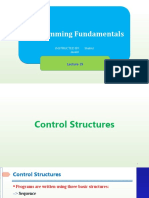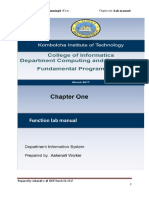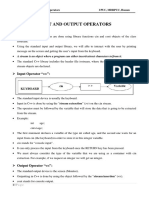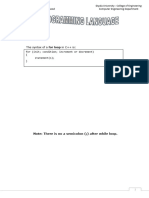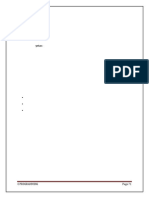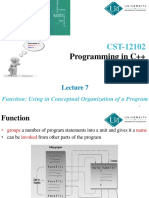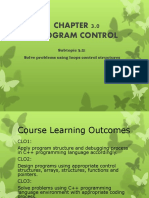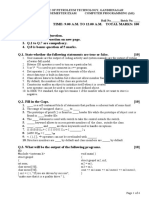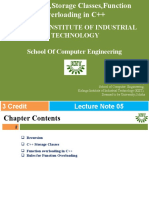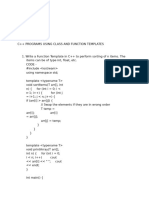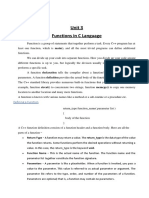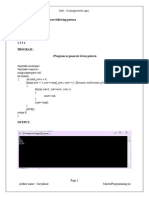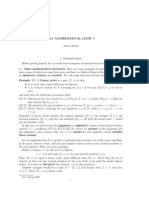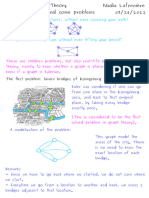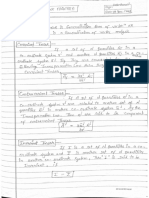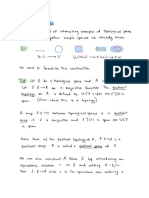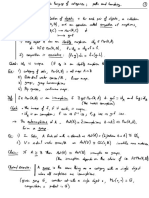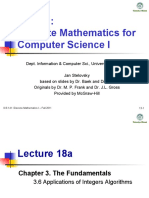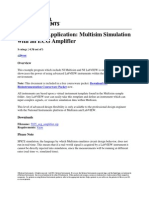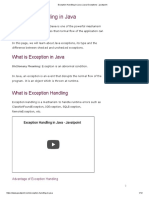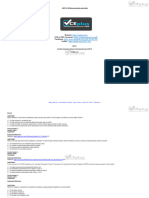C++ Progrmming Unit II
C++ Progrmming Unit II
Uploaded by
JaZz SFCopyright:
Available Formats
C++ Progrmming Unit II
C++ Progrmming Unit II
Uploaded by
JaZz SFCopyright
Available Formats
Share this document
Did you find this document useful?
Is this content inappropriate?
Copyright:
Available Formats
C++ Progrmming Unit II
C++ Progrmming Unit II
Uploaded by
JaZz SFCopyright:
Available Formats
BCA – IstYr
Programming in C++
Prof. Amit Singla, HOD (Comp Dept), S D PG College, SGNR Page 1 of 21
Unit - II
Looping (Iteration):
The iteration (looping) statements allow a set of instructions to be performed repeatedly until a certain
condition is fulfilled. The iteration statements are also called loops or looping statements.
C++ provides three kinds of loops:
• For loop
• While loop
• Do-while loop
(1) The while loop:
The while loop is an entry-controlled loop. It means the control conditions are tested before the start of
loop’s execution. If the conditions are not satisfied then body of loop will not be executed and control will
be transferred out of the loop.
The syntax of a while loop is
while(condition)
{
body of loop;
}
Example: Program to calculate the factorial of an entered number.
#include<iostream.h>
#include<conio.h>
void main( )
{
intnum, fact;
clrscr( );
cout<< “Enter the number:-“;
cin>>num;
fact = 1;
while(num>0)
{
fact = fact*num;
num--;
}
cout<<endl<< “The factorial of given number is : -“ << fact;
}
Prof. Amit Singla, HOD (Comp Dept), S D PG College, SGNR Page 2 of 21
(2) The do-while loop:
The do-while loop is an exit-controlled loop, that is, the control conditions are tested at the bottom of the
loop after executing its loop-body statements. This means that a do-while loop always executes at least once,
even when the condition is false initially. The most common use of this loop is in menu selection function.
The syntax of a do-while loop is
do
{
body of loop;
} while(condition);
Example: Program to calculate the factorial of an entered number.
#include<iostream.h>
#include<conio.h>
void main( )
{
intnum, fact;
clrscr( );
cout<< “Enter the number:-“;
cin>>num;
fact = 1;
if (num = = 0)
{
cout<<endl<< “The factorial of given number is : -“ << fact;
exit( );
}
do
{
fact = fact*num;
num--;
} while(num>0);
cout<<endl<< “The factorial of given number is : -“ << fact;
}
Prof. Amit Singla, HOD (Comp Dept), S D PG College, SGNR Page 3 of 21
(3) The for loop:
The For loop is easiest loop to be used in C++. Like while loop it is also an entry-controlled loop. In this
loop, the loop control elements (initialization, condition & increment/decrement) are gathered in one place,
while in other loops they are scattered over the program and difficult to understand.
The syntax of a for loop is
for(initialization; condition; increment/decrement)
{
body of loop;
Here,
Initialization expression: It is executed only once when the loop first starts. It provides the loop variable
an initial value.
Condition expression: It involves relational operators. It is executed every time through the loop before the
body of the loop is executed. If the condition is true, the body of the loop is executed, and if false, the
control comes out of the loop.
Increment/Decrement expression: It is always executed at the end of the loop, after the body of the loop.
Example: Program to calculate the factorial of an entered number.
#include<iostream.h>
#include<conio.h>
void main( )
{
intnum, fact;
clrscr( );
cout<< “Enter the number:-“;
cin>>num;
for(fact=1; num>0; num--)
{
fact = fact*num;
cout<<endl<< “The factorial of given number is : -“ << fact;
}
Prof. Amit Singla, HOD (Comp Dept), S D PG College, SGNR Page 4 of 21
• Nested Loops:
Nesting of loops means one or more loop(s) within a loop. In nested loop the inner loop is executed
first and then outer. The nested loop must be used to input or output multi-dimensional array
elements. In nested loops the value of outer loop control variable will change only after the inner
loop has been completely executed.
Example: Program to print the following output
*
**
***
#include<iostream.h>
#include<conio.h>
void main( )
{
intnum, i, j;
cout<<“Enter the number of line to be print:-“;
cin>>num;
for(i=1; i<=num; i++)
{
for(j=1; j<=i; j++)
{
cout<<“*”;
}
cout<<“\n”;
}
}
JUMP Statements:
The jump statements unconditionally transfer program control within a function. C++ has three statements
that perform an unconditional branch: goto, break, and continue.
(a) The goto Statement: A goto statement can transfer the program control anywhere in the
program. The target destination of a goto statement is marked by a label. The target label and
goto must appear in the same function.
Syntax:
goto label;
.
.
label :
herelabel is a user supplied identifier and can appear either before or after goto.
Prof. Amit Singla, HOD (Comp Dept), S D PG College, SGNR Page 5 of 21
Example: WAP to print 10 to 1 numbers
#include<iostream.h>
#include<conio.h>
void main( )
{
int n = 10;
loop:
cout<< n;
n = n – 1;
if(n>0)
{
goto loop;
}
getch( );
}
(b) The break Statement: The break statement enables a program to skip over part of the
code. A break statement terminates the smallest enclosing while, do-while, for or switch
statement. Execution resumes at the statement immediately following the body of the terminated
statement.
Example: To stop the countdown before its natural end
#include <iostream.h>
void main ( )
{
int n;
for (n=10; n>0; n--)
{
cout<< n << ", ";
if (n==3)
{
cout<< "countdown aborted!";
break;
}
}
Prof. Amit Singla, HOD (Comp Dept), S D PG College, SGNR Page 6 of 21
getch();
}
(c) The continue Statement: The continue is another jump statement like the break
statement as both the statements skip over a part of the code. But the continue statement is
somewhat different from break. Instead of forcing termination, it forces the next iteration of the
loop to take place, skipping any code in between.
Example:
#include <iostream.h>
#include <conio.h>
void main ( )
{
int a, b;
charch;
clrscr( );
do
{
cout<< “\n Enter the dividend & divisor : - “;
cin>> a >> b;
if (b == 0)
{
cout<< "\n Illegal Divisior !!!”;
continue;
}
cout<< "\n Quotient is :” << a/b;
cout<< “\n Do you have another one ? (y/n) :”;
cin>>ch;
} while (ch==’y’ || ch==’Y’);
getch( );
}
Prof. Amit Singla, HOD (Comp Dept), S D PG College, SGNR Page 7 of 21
Pointer: A pointer is a variable that contains the address of another same type of variable.
The general form of a pointer variable declaration is –
type *var_name;
Here, type is the pointer's base type; it must be a valid C++ data type and var-name is the
name of the pointer variable. The symbol (asterisk) * used to declare a pointer.
For Example:
int *a, *b;
char *ch, *ch1;
Initialization of Pointer variable
Pointer Initialization is the process of assigning address of a variable to pointer variable. Pointer variable
contains address of variable of same data type. In C++ language address operator(&) is used to determine
the address of a variable. The address operator(&) returns the address of the variable associated with it.
int a = 10 ;
int *ptr ; //pointer declaration
ptr = &a ; //pointer initialization
Benefits of using pointers
• Pointers are more efficient in handling Array and Structure.
• Pointer allows references to function and thereby helps in passing of function as arguments to other
function.
• It reduces length of the program and its execution time.
• It allows C++ to support dynamic memory management.
• Pointers provide direct access to memory
• Pointers provide a way to return more than one value to the functions
Disadvantages of Pointers
• Uninitialized pointers might cause segmentation fault.
• Dynamically allocated block needs to be freed explicitly. Otherwise, it would lead to memory leak.
• Pointers are slower than normal variables.
• If pointers are updated with incorrect values, it might lead to memory corruption.
Prof. Amit Singla, HOD (Comp Dept), S D PG College, SGNR Page 8 of 21
Functions: Functions are building blocks or self-contained block of statements that perform a
specific task. A large program can be broken down into number of smaller, self-contained components; each
has some unique and identifiable function. Each function has its own name.
There are two types of functions in C++ programming:
• Standard library functions: The standard library functions are built-in functions in C++
programming to handle tasks such as mathematical computations, I/O processing, string handling
etc. These functions are defined in the header file. When the specific header file is included these
functions are available for use.
For example:
isalpha( ), isdigit( ), isupper( ), islower( ), etc. are character functions available in ctype.h
header file.
• User defined functions: C++ allows programmers to define their own functions. These
functions are defined by the user to meet their requirements are known as user defined functions.
Every function in C++ consists of following components:
(a) Function Declaration
(b) Function Definition
(c) Function Call
(a) Function declaration: A function declaration tells the compiler about a function
name and how to call the function. The actual body of the function can be defined separately.
A function declaration has the following parts −
return_typefunction_name( parameter list );
For Example
int max(int num1, int num2);
Parameter names are not important in function declaration only their type is required, so
following is also valid declaration −
int max(int, int);
(b) Function definition: A function definition contains a function declaration and the body of
the function. A function can only have one definition. The function definition consists of the
function header and its body. The header is same like the function prototype, except that it
contains no terminating semicolon.
The general form of a C++ function definition is as follows −
Prof. Amit Singla, HOD (Comp Dept), S D PG College, SGNR Page 9 of 21
return_typefunction_name( parameter list )
{
body of the function;
}
For example:
Following is the function called max(). This function takes two parameters num1 and
num2 and return the biggest of both −
// function returning the max between two numbers
int max(int num1, int num2)
{
int result;
if (num1 > num2)
result = num1;
else
result = num2;
return result;
}
(c) Function Call: To execute the codes of function body, the user-defined function needs
to be called. A function can be called by specifying the function name followed by a list of
arguments separated by commas enclosed in the pair of parentheses. Each function call is
terminated by semicolon.
For example:
int m;
m = max(10, 20);
Example: Finding the factorial of given number using function.
#include<iostream.h>
#include<conio.h>
void main()
{
Prof. Amit Singla, HOD (Comp Dept), S D PG College, SGNR Page 10 of 21
inti,f,num;
int fact(int); // Function Declaration
clrscr();
cout<<"Enter any number: ";
cin>>num;
f=fact(num); // Function Call
cout<<"\n Factorial is: "<<f;
getch();
}
int fact(int n) // Function Definition
{
int x;
if(n ==0)
{
return(1);
}
while(n>0)
{
x = x *n;
n--;
}
return (n);
}
Argument passing techniques: There are two ways for passing the arguments in a functions:
o Call by Value
o Call by Reference
• Call by Value: By default, arguments in C++ are passed by value. This method copies the
actual value of an argument into the formal parameter of the function. In this case, changes made to
the parameter inside the function have no effect on the argument.
Prof. Amit Singla, HOD (Comp Dept), S D PG College, SGNR Page 11 of 21
Example: Swapping of two values with the use of call by value.
#include<iostream.h>
#include<conio.h>
void main()
{
int m = 22, n = 44;
void swap(int, int);
cout<<" Values before swapping “;
cout<< “\n m =” << m <<”and n =” << n;
swap(m, n); // calling swap function by value
}
void swap(int a, int b)
{
inttmp;
tmp = a;
a = b;
b = tmp;
cout<<" \nValues after swapping “
cout<< “\n m =” << a <<”and n =” <<b;
}
• Call by Reference: In call by reference, original value is changed or modified because
address of the variable is passed to the function. In this case actual and formal arguments share the
same address space. Hence, any value changed inside the function, is reflected inside as well as
outside the function. The &(address) operator is used for passing the addresses of the values.
Example: Swapping of two values with the use of call by value.
#include<iostream.h>
#include<conio.h>
void main()
{
int a=100, b=200;
Prof. Amit Singla, HOD (Comp Dept), S D PG College, SGNR Page 12 of 21
void swap(int *, int *);
swap(&a,&b); // passing addresses to function
cout<<"Value of a"<<a;
cout<<"Value of b"<<b;
getch();
}
void swap(int*a,int*b)
{
int temp;
temp=*a;
*a=*b;
*b=temp;
}
Difference between call by value and call by reference
Call by value Call by reference
This method copy original value into function
1 This method copy address into function as an arguments.
as an arguments.
Changes made to the parameter inside the Changes made to the parameter affect the argument.
2
function have no effect on the argument. Because address is used to access the actual argument.
Actual and formal arguments will be created Actual and formal arguments will be created in same
3
in different memory location memory location
Advantages of Functions:
• C++ functions are used to avoid rewriting same logic/code again and again in a program.
• There is no limit in calling C++ functions to make use of same functionality wherever required.
• We can call functions any number of times in a program and from any place in a program.
• A large C++ program can easily be tracked when it is divided into functions.
• The core concept of C++ functions are, re-usability, dividing a big task into small pieces to achieve
the functionality and to improve understandability of very large C++ programs.
• It makes the program easier to design and understand.
Prof. Amit Singla, HOD (Comp Dept), S D PG College, SGNR Page 13 of 21
Recursion (Recursive Function) in C++
The function which calls same function is called recursive function. In other words when a function calls
itself then that function is called Recursive function.
Recursive function is very useful to solve many mathematical problems like to calculate factorial of a
number, generating Fibonacci series, etc.
Advantage of Recursion
• Method calling related information will be maintained by recursion.
• Stack evaluation will be take place by using recursion.
• Infix prefix, post-fix notation will be evaluated by using recursion.
Disadvantage of Recursion
• It is a very slow process due to stack overlapping.
• Recursive programs can create stack overflow.
• Recursive method can create as loops.
Example: Finding the factorial of given number using recursion.
#include<iostream.h>
#include<conio.h>
void main()
{
inti,f,num;
int fact(int);
clrscr();
cout<<"Enter any number: ";
cin>>num;
f=fact(num);
cout<<"Factorial: "<<f;
getch();
}
int fact(int n)
{
Prof. Amit Singla, HOD (Comp Dept), S D PG College, SGNR Page 14 of 21
if(a==0)
{
return(1);
}
else
{
return(n*fact(n-1)); // Recursion
}
}
Functions Returning Pointers: The way a function can return an int, a float, or reference or
any other data types, it can even return a pointer. The general form of a function returning a pointer is
type *function_name (argument list);
Here, type specifies the pointer type being returned by the function specified by function_name.
Example:
#include<iostream.h>
#include<conio.h>
void main( )
{
int a, b, *c;
int *big(int&, int&);
clrscr( );
cout<<”\nEnter two integers :-“;
cin>>a >>b;
c = big(a,b);
cout<<”\nThe bigger value is :-“ << *c;
getch( );
}
int *big(int&x, int&y)
{
if(x>y)
return(&x);
else
return(&y);
}
Prof. Amit Singla, HOD (Comp Dept), S D PG College, SGNR Page 15 of 21
Passing Pointers as argument:
Same as Call by Reference described in earlier topic
Function Overloading: C++ allows specification of more than one function of the same name
in the same scope. These are called overloaded functions. Function overloading is a feature of C++ that
allows to create multiple functions with the same name, so long as they have different parameters. That
means the same name to more than one function if they have either a different number of parameters or
different types in their parameter.
For example:
int test() { }
int test(int a) { }
float test(double a) { }
int test(int a, double b) { }
Example:
#include<iostream.h>
#include<conio.h>
Class addition
{
public:
void sum(int a,int b)
{
cout<<a+b;
}
void sum(int a,int b,int c)
{
cout<<a+b+c;
}
void sum(float a, float b)
{
cout<<a+b;
}
};
Prof. Amit Singla, HOD (Comp Dept), S D PG College, SGNR Page 16 of 21
void main()
{
clrscr();
additionobj;
obj.sum(10,20);
cout<<endl;
obj.sum(10,20,30);
cout<<endl;
obj.sum(2.5, 6.5);
getch( );
}
Structures: Structure is a user defined data type. It is a collection of variables of different data
types under a single name. For example, if user wants to store some information about a person: his/her
name, citizenship number and salary. User can easily create different variables name, citNo, salary to store
this information separately.
The struct keyword is used to define a structure type followed by a structure name. Once the structure is
declared the structure variable is defined in the main( ) program. The members of a structure are accessed
using a dot (,) operator.
Syntax
struct<structure name>
{
Members;
};
Example:
struct person
{
char name[50];
int age;
float salary;
};
Prof. Amit Singla, HOD (Comp Dept), S D PG College, SGNR Page 17 of 21
For Example1:
C++ Program to assign data to members of a structure variable and display it.
#include <iostream.h>
#include <conio.h>
struct person
{
char name[50];
int age;
float salary;
};
void main()
{
person p1;
cout<< "Enter Full name: ";
cin.get(p1.name, 50);
cout<< "Enter age: ";
cin>> p1.age;
cout<< "Enter salary: ";
cin>> p1.salary;
cout<< "\nDisplaying Information." <<endl;
cout<< "Name: " << p1.name <<endl;
cout<<"Age: " << p1.age <<endl;
cout<< "Salary: " << p1.salary;
getch( );
}
For Example 2:
Passing structure to function in C++
A structure variable can be passed to a function in similar way as normal argument. Consider this
example:
Prof. Amit Singla, HOD (Comp Dept), S D PG College, SGNR Page 18 of 21
#include <iostream.h>
#include <conio.h>
struct person
{
char name[50];
int age;
float salary;
};
void main()
{
person p1;
voiddisplaydata(person); // function declaration
cout<< "Enter Full name: ";
cin.get(p1.name, 50);
cout<< "Enter age: ";
cin>> p1.age;
cout<< "Enter salary: ";
cin>> p1.salary;
displaydata(p1); // function call
getch( );
}
voiddisplaydata(person p)
{
cout<< "\nDisplaying Information." <<endl;
cout<< "Name: " << p.name <<endl;
cout<<"Age: " <<p.age<<endl;
cout<< "Salary: " <<p.salary;
Prof. Amit Singla, HOD (Comp Dept), S D PG College, SGNR Page 19 of 21
Structures and Pointers: The pointers to structures are known as structure pointers. The
structure pointers are declared by placing asterisk (*) in front of a structure pointer’s name. The general
form is:
struct_name *struct_pointer;
Example
struct date
{
intdd, mm, yy;
}
void main( )
{
date *dt_ptr; // structure pointer
}
The members of structures are accessed using arrow operator (->).
struct date
{
intdd, mm, yy;
}
void main( )
{
date *dt_ptr;
dt_ptr->dd = 15;
}
Containers
Containers are the objects used to store multiple elements of the same type or different. The container
manages the storage space for its elements and provides member functions to access them, either directly or
through iterators (reference objects with similar properties to pointers).Depending on that they can be further
classified as −
• Sequence containers: They are used for data structures that store objects of the same type in
a linear manner.For example: array, vector, list
Prof. Amit Singla, HOD (Comp Dept), S D PG College, SGNR Page 20 of 21
• Associative containers: They provide sorted data structures that provide a fast lookup (O(log
n) time) using keys.For Example: set, map, multimap
• Unordered Associative containers: They provide unsorted data structures that can be accessed
using a hash. Access times are O(n) in the worst-case, but much faster than linear time for most
operations.For Example: unordered_set, unordered_map
• Container Adapter: They are a special type of container class. They are not full container classes
on their own, but wrappers around other container types. For Example:stack, queue
Prof. Amit Singla, HOD (Comp Dept), S D PG College, SGNR Page 21 of 21
You might also like
- Fighting Inflammation - Harvard HealthDocument2 pagesFighting Inflammation - Harvard HealthJaZz SF0% (4)
- Project Report On Micromax MobilesDocument25 pagesProject Report On Micromax MobilesAnilGoyal100% (2)
- Oops Module 2Document34 pagesOops Module 2sonaprabu2015No ratings yet
- Lecture 5Document39 pagesLecture 5fakhrialamqaziNo ratings yet
- (Document Title) : Government Postgraduate College JhangDocument73 pages(Document Title) : Government Postgraduate College JhangMUHAMMAD SALEEM RAZANo ratings yet
- C++ Cha3Document16 pagesC++ Cha3Bacha TarikuNo ratings yet
- C ProgrammingDocument22 pagesC ProgrammingGaneshanNo ratings yet
- LoopsDocument7 pagesLoopsusoul683No ratings yet
- Unit 3 - CH 1.decision Making and LoopingDocument30 pagesUnit 3 - CH 1.decision Making and LoopingManjunatha H RNo ratings yet
- Programming Fundamentals: Instructed By: Shahid JavaidDocument49 pagesProgramming Fundamentals: Instructed By: Shahid JavaidHafiz HamzaNo ratings yet
- Unit 2.6 For, Do, While LoopDocument40 pagesUnit 2.6 For, Do, While LoopSanya SharmaNo ratings yet
- LoopsDocument23 pagesLoopsHend TalafhaNo ratings yet
- ) Chapter One (: Fundamentals of Programming2 (Lab Manual)Document18 pages) Chapter One (: Fundamentals of Programming2 (Lab Manual)Ashenafi Workie DessalgnNo ratings yet
- Practical 1: Introduction of C++ Programming: Firstly, We Know About WHAT IS C++ PROGRAMMING LANGUAGE ?Document21 pagesPractical 1: Introduction of C++ Programming: Firstly, We Know About WHAT IS C++ PROGRAMMING LANGUAGE ?Simran KaurNo ratings yet
- While LoopDocument27 pagesWhile Loop221090No ratings yet
- IMS450 - Chapter 6Document47 pagesIMS450 - Chapter 6nurulaina0858No ratings yet
- While: 290 - Chapter 5: Control Structures II (Repetition)Document13 pagesWhile: 290 - Chapter 5: Control Structures II (Repetition)jeremyNo ratings yet
- Chapter 9 - Input and Output OperatorsDocument5 pagesChapter 9 - Input and Output Operatorsnagendra100% (1)
- Lecture 5&6 - Control StructuresDocument28 pagesLecture 5&6 - Control StructureswanyekilynnNo ratings yet
- Lecture 7Document14 pagesLecture 7Dr LolaNo ratings yet
- ThirdDocument3 pagesThirdabdullahabd7opNo ratings yet
- Itp Unit-2Document9 pagesItp Unit-2manaswani BhandaramNo ratings yet
- C Programming Part 8Document10 pagesC Programming Part 8molocof324No ratings yet
- Loop Constructs: by Ansar Javed Department of Computer Science, Capital University of Science and Technology, IslamabadDocument44 pagesLoop Constructs: by Ansar Javed Department of Computer Science, Capital University of Science and Technology, IslamabadMalak Nizar AlamNo ratings yet
- Chapter FiveDocument34 pagesChapter Fivegelgeuk02No ratings yet
- Lec 06 Functions IDocument40 pagesLec 06 Functions Iابانوب سامي بولسNo ratings yet
- Chapter 3Document53 pagesChapter 3Priyansh JainNo ratings yet
- 01 Introduction 2 PDFDocument10 pages01 Introduction 2 PDFمنهاج الحياةNo ratings yet
- Lecture 3Document23 pagesLecture 3md emam hossainNo ratings yet
- Computer Programming Lab Lab Journal - 5: ObjectiveDocument5 pagesComputer Programming Lab Lab Journal - 5: ObjectivefurqanNo ratings yet
- Module-14 - 1-C For LoopDocument20 pagesModule-14 - 1-C For LoopMae MaeNo ratings yet
- CS Practical Class 12Document60 pagesCS Practical Class 12Beenu PuriNo ratings yet
- Session 5Document36 pagesSession 5studyurselfNo ratings yet
- CP - Unit 1 - 2Document43 pagesCP - Unit 1 - 226Bhutesh kumar meher ITNo ratings yet
- Lab Report 1Document8 pagesLab Report 1Shayan UmarNo ratings yet
- Lecture 5Document18 pagesLecture 5BADR ESLAMNo ratings yet
- Mathematics & Computer Programming: Toqeer MahmoodDocument15 pagesMathematics & Computer Programming: Toqeer MahmoodadanNo ratings yet
- Lab_Assignment3_solutionDocument5 pagesLab_Assignment3_solutionmukuljd99No ratings yet
- Course C++Document23 pagesCourse C++aya Mohamed abdelrahmanNo ratings yet
- Lecture7 - Function Using in Conceptual Organization of A ProgramDocument50 pagesLecture7 - Function Using in Conceptual Organization of A ProgramPyae LinnNo ratings yet
- C Programming (Unit-3,4,5)Document56 pagesC Programming (Unit-3,4,5)csksathya30No ratings yet
- Chapter 8 - Code Optimization Part 2Document3 pagesChapter 8 - Code Optimization Part 2Aschalew AyeleNo ratings yet
- New EditedDocument104 pagesNew EditeddhaneshfreefireNo ratings yet
- Programmig CollectionDocument20 pagesProgrammig CollectionBeakale Abreham TibebuNo ratings yet
- Unit 1Document29 pagesUnit 1ashishadicted4No ratings yet
- For Loop ES081 PART BDocument21 pagesFor Loop ES081 PART BDavid AlingasaNo ratings yet
- Program Control (3.2)Document23 pagesProgram Control (3.2)intensityNo ratings yet
- Int P Ne/v Int (25) Float Q New Float (7.5)Document49 pagesInt P Ne/v Int (25) Float Q New Float (7.5)NAAC DataNo ratings yet
- C++ Lab ReportsDocument77 pagesC++ Lab Reportsmudassir ahmadNo ratings yet
- Institute of Petroleum Technology, Gandhinagar B.Tech 2007-End Semester Exam Computer Programming (161) Roll No. - Batch No.Document4 pagesInstitute of Petroleum Technology, Gandhinagar B.Tech 2007-End Semester Exam Computer Programming (161) Roll No. - Batch No.darshanNo ratings yet
- OOP-7 Recursion, Storage Classes, Function OverloadingDocument11 pagesOOP-7 Recursion, Storage Classes, Function OverloadingBirendra Kumar BhagatNo ratings yet
- Chapter Three Controls and Decisions: Else Statement2Document6 pagesChapter Three Controls and Decisions: Else Statement2yimerNo ratings yet
- Master of Computer Application (MCA) - Semester 2 MC0066 - OOPS Using CDocument8 pagesMaster of Computer Application (MCA) - Semester 2 MC0066 - OOPS Using CArvind KumarNo ratings yet
- Chapter 5 Repetition Control StructuresDocument28 pagesChapter 5 Repetition Control Structuresnicole.santosNo ratings yet
- Chapter 4Document34 pagesChapter 4mehari kirosNo ratings yet
- Ra2311047010216 Oodp AssignmentDocument14 pagesRa2311047010216 Oodp AssignmentpurviNo ratings yet
- C Basics LoopDocument20 pagesC Basics LoopAkixia Sta. CruzNo ratings yet
- Chapter 9 Input Output OperatorsDocument12 pagesChapter 9 Input Output Operatorstanisharavind777No ratings yet
- Functions in UNIt 3C LanguageDocument17 pagesFunctions in UNIt 3C LanguageBhanu Prakash ReddyNo ratings yet
- CPP PgdcaDocument112 pagesCPP Pgdcautkarshkumarshrivastava4No ratings yet
- Break Continue GotoDocument8 pagesBreak Continue GotoConnie BaelloNo ratings yet
- World's Most Famous Math Problem - The Proof of Fermat's Last Theorem and Other Mathematical Mysteries (PDFDrive)Document93 pagesWorld's Most Famous Math Problem - The Proof of Fermat's Last Theorem and Other Mathematical Mysteries (PDFDrive)JaZz SFNo ratings yet
- 141A NotesDocument75 pages141A NotesJaZz SFNo ratings yet
- 03 28 Basic DefinitionsDocument4 pages03 28 Basic DefinitionsJaZz SFNo ratings yet
- Tensor AlgebraDocument48 pagesTensor AlgebraJaZz SFNo ratings yet
- Week 6Document11 pagesWeek 6JaZz SFNo ratings yet
- C++ Programming Unit IIIDocument22 pagesC++ Programming Unit IIIJaZz SFNo ratings yet
- AdviceDocument5 pagesAdviceJaZz SFNo ratings yet
- Zosvphhdxr1205h5km21pleaDocument8 pagesZosvphhdxr1205h5km21pleaJaZz SFNo ratings yet
- Teshima Laura PHD 2022Document136 pagesTeshima Laura PHD 2022JaZz SFNo ratings yet
- C++ Progrmming Unit IDocument24 pagesC++ Progrmming Unit IJaZz SFNo ratings yet
- HW 4Document1 pageHW 4JaZz SFNo ratings yet
- Section 9 - Compact SpacesDocument9 pagesSection 9 - Compact SpacesJaZz SFNo ratings yet
- Mathsem 118Document4 pagesMathsem 118JaZz SFNo ratings yet
- Section 16 - Quotients and GluingDocument6 pagesSection 16 - Quotients and GluingJaZz SFNo ratings yet
- Section 19 - Deformation Retracts and Homotopy EquivalenceDocument6 pagesSection 19 - Deformation Retracts and Homotopy EquivalenceJaZz SFNo ratings yet
- Topology Category and HomotopyDocument4 pagesTopology Category and HomotopyJaZz SFNo ratings yet
- Math 231br (Advanced Algebraic Topology) Lecture Notes: Taught By: Professor Michael Hopkins Notetaker: Yuchen FuDocument77 pagesMath 231br (Advanced Algebraic Topology) Lecture Notes: Taught By: Professor Michael Hopkins Notetaker: Yuchen FuJaZz SFNo ratings yet
- 5th Sem MathDocument3 pages5th Sem MathJaZz SFNo ratings yet
- Number Theory NotesDocument112 pagesNumber Theory NotesJaZz SFNo ratings yet
- Exam Question Complex AnalysisDocument3 pagesExam Question Complex AnalysisJaZz SFNo ratings yet
- Math Problems Quest Paper bsc1Document2 pagesMath Problems Quest Paper bsc1JaZz SFNo ratings yet
- TNbookDocument340 pagesTNbookJaZz SFNo ratings yet
- Class Work 3 All Subjects STD VDocument50 pagesClass Work 3 All Subjects STD Vnituy6305No ratings yet
- Compatible USB Device List For MX49/MX61/MX88: Manufacturer Model NoteDocument5 pagesCompatible USB Device List For MX49/MX61/MX88: Manufacturer Model NoteJeffreyAnciano MercesLetiferNo ratings yet
- Biological and Chemical Weapons - Our World in DataDocument3 pagesBiological and Chemical Weapons - Our World in DataKLINIK PRATAMA MUSLIMATNo ratings yet
- Taas, YV II MSPowerPoint - OutputDocument16 pagesTaas, YV II MSPowerPoint - OutputYVETTE TAAS100% (1)
- ICS141: Discrete Mathematics For Computer Science IDocument28 pagesICS141: Discrete Mathematics For Computer Science IMahmoud Abdel-SalamNo ratings yet
- Manual FlashLock V222 T05 EnglishDocument20 pagesManual FlashLock V222 T05 EnglishWalther0% (1)
- CCNA 4 Chapter 7 V4.0 AnswersDocument8 pagesCCNA 4 Chapter 7 V4.0 Answersccnadiscovery4No ratings yet
- Event HandlingDocument97 pagesEvent Handlingk9172056115No ratings yet
- NtbtlogDocument35 pagesNtbtlogRanzozo KizaNo ratings yet
- Example Program - Multisim Simulation With An ECG AmplifierDocument6 pagesExample Program - Multisim Simulation With An ECG AmplifierSalaar PearlNo ratings yet
- Reviced Exit-ExamDocument22 pagesReviced Exit-Examtyv89783No ratings yet
- Exception Handling in Java - Java Exceptions - JavatpointDocument12 pagesException Handling in Java - Java Exceptions - JavatpointHari KrishnanNo ratings yet
- Asset ImpairmentDocument5 pagesAsset ImpairmentBalaji ShindeNo ratings yet
- 06 Potentizer ManualDocument6 pages06 Potentizer ManualStere StereNo ratings yet
- Quantum All ProductsDocument93 pagesQuantum All ProductsPavan Kumar DevathaNo ratings yet
- UNIT-1 (OS) : Introduction To Operating SystemDocument19 pagesUNIT-1 (OS) : Introduction To Operating SystemVishant ChaudharyNo ratings yet
- Systemboard Viewer PDFDocument19 pagesSystemboard Viewer PDFD.B Kim (aka akuma)No ratings yet
- IAPP Premium CIPP-E by - VCEplus 90q-DEMODocument33 pagesIAPP Premium CIPP-E by - VCEplus 90q-DEMOendragianNo ratings yet
- Digidesign FAQDocument142 pagesDigidesign FAQMisakiAyuzawa97No ratings yet
- BK 2202 Ultrasound System - User ManualDocument86 pagesBK 2202 Ultrasound System - User Manualhakep112No ratings yet
- 2.5. LBB 1938Document2 pages2.5. LBB 1938design mepNo ratings yet
- br5 Scheda en 0Document2 pagesbr5 Scheda en 0Mihai BordeianuNo ratings yet
- Silicon Chip 032022Document116 pagesSilicon Chip 032022CODE PowerNo ratings yet
- Ew675ut Ex665ut Ex565ut Ew675uti Ex665uti Series Service Manual v4.0Document110 pagesEw675ut Ex665ut Ex565ut Ew675uti Ex665uti Series Service Manual v4.0Carlos Eduardo AbrantesNo ratings yet
- Illustra PRO Gen4 Outdoor PTZ Data Sheet V4Document5 pagesIllustra PRO Gen4 Outdoor PTZ Data Sheet V4unstrainNo ratings yet
- Teddy AIDocument7 pagesTeddy AIQuotes 'nd notesNo ratings yet
- TS12864A 2 (Blue)Document12 pagesTS12864A 2 (Blue)marcokersulrodriguesNo ratings yet
- Easy Guide - Admin Contribution PaymentDocument52 pagesEasy Guide - Admin Contribution PaymentKOGIELAANo ratings yet
- Chendu College of Engineering & TechnologyDocument5 pagesChendu College of Engineering & Technologyanish.t.pNo ratings yet









